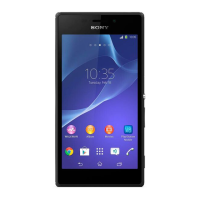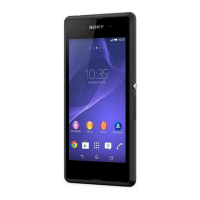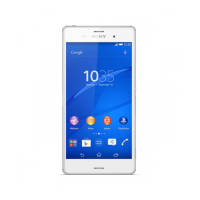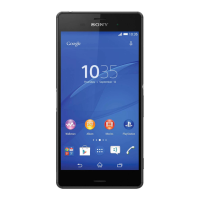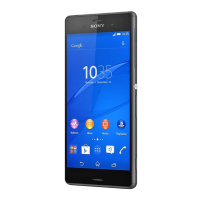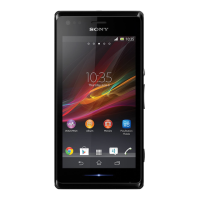Do you have a question about the Sony D2005 and is the answer not in the manual?
Details the phone's physical components and their functions.
Instructions for attaching the back cover and inserting SIM/memory cards.
Guides through the initial setup process and configuration.
Instructions on how to charge the device and understand battery status lights.
Explains basic touch gestures like tapping, touching and holding, pinching, spreading, and swiping.
Describes the device's Home screen, its panes, and how to navigate them.
Details how to view, move, add, and uninstall applications on the device.
Instructions on adding, resizing, moving, and deleting widgets on the Home screen.
How to use shortcuts and folders to organize applications on the Home screen.
Customizing the Home screen and lock screen with wallpapers and themes.
Method to capture images of the device screen.
Understanding status bar icons and handling notifications.
Brief descriptions of pre-installed applications and their functions.
Steps to download apps from the Google Play Store, requiring a Google account.
Enabling and downloading apps from unknown sources for security.
How to use the Google Chrome browser for web browsing.
Configuring APN settings for Internet and MMS, including manual setup.
Turning on Wi-Fi, connecting to networks, and adding networks manually.
Sharing the device's data connection via USB tethering or Wi-Fi hotspot.
Tracking and managing mobile data usage, setting warnings and limits.
Manually selecting network types and service providers for connectivity.
Setting up and connecting to virtual private networks for secure access.
Setting up and manually synchronizing Google accounts for data backup.
Setting up corporate email, calendar, and contacts synchronization.
Accessing device settings via the Notification panel or Application screen.
Adjusting ringtone, media volume, and setting vibrate/silent modes.
Locking/unlocking the SIM card and changing the PIN for security.
Adjusting screen brightness and idle time before the screen turns off.
Creating and changing screen lock patterns, PINs, and passwords.
Changing the device's display language for user interface.
Manually setting the date, time, and time zone on the device.
Using Clear Phase and xLOUD technologies for better sound quality.
Using the virtual keyboard for text entry, including gestures and character input.
Using voice input for text entry instead of typing words.
Selecting, cutting, copying, and pasting text in portrait and landscape modes.
Customizing keyboard settings, languages, and layout variants.
How to make calls manually, from contacts, call log, or using smart dial.
How to answer, decline, mute, or reject incoming calls with messages.
Managing ongoing calls, changing volume, and activating the screen.
Viewing missed calls, calling back, adding to contacts, and hiding the log.
Setting up and turning off call forwarding to another number or service.
Blocking calls and using Fixed Dialing Numbers (FDNs) for call control.
Activating and handling multiple calls, including conference calls.
Setting up and using the voicemail service to receive messages.
Making emergency calls using international numbers, with or without a SIM card.
Methods for transferring contacts from old devices or online accounts.
Finding, filtering, adding, editing, and deleting contacts in the app.
Marking contacts as favorites and assigning them to groups for organization.
Sharing contact details via various methods like Bluetooth or messaging.
Exporting contacts to a memory card or SIM card for backup.
Creating, sending, and reading text and multimedia messages.
Changing notification settings and delivery reports for messages.
Using the Hangouts app for chat and video calls with friends.
Configuring email accounts, including corporate accounts, on the device.
Downloading, reading, creating, replying, and forwarding emails.
Activating and using the preview pane for landscape email viewing.
Removing accounts, changing inbox frequency, and setting auto-reply.
Using the Gmail app for reading and writing email messages.
Methods to transfer music files from a computer to the device.
Using the WALKMAN app to play music and audio books.
Overview of the WALKMAN app's main screen and features.
Creating, playing, adding to, and deleting playlists for music organization.
Sharing music via applications and on Facebook™™.
Improving sound quality using equalizer and surround sound features.
Turning on the visualizer and changing background themes for music playback.
Using TrackID to identify music playing in surroundings and discover related info.
Connecting headphones and using the FM radio app to listen to stations.
Adjusting radio sound mode, region, and visualizer settings.
Instructions for taking photos and recording videos using the device.
Enabling geotagging to add location data to photos.
Configuring capture modes, quick launch, touch capture, and shutter sound.
Adjusting resolution, white balance, self-timer, HDR, and image stabilizer.
Adjusting video resolution, self-timer, and microphone settings for recordings.
Browsing and viewing photos/videos in the Album app, including slideshows.
Sharing, using as contact pics/wallpaper, rotating, and deleting media.
Turning on photo analysis and naming faces for organization.
Editing photos by cropping, applying effects, and adjusting settings.
Managing photo albums, online services, and adding comments.
Viewing photos with geotagged locations on a map or globe.
Playing downloaded or saved videos, changing settings, and sharing.
Methods to transfer video files from computers or other devices.
Getting and clearing video information, and deleting video files.
Turning on Bluetooth, pairing, connecting, and naming the device.
Sharing files like photos, music, and contacts via Bluetooth.
Connecting via USB cable or Bluetooth for data transfer and management.
Installing and using PC Companion for device management and updates.
Connecting and using a headset for calls and music playback.
Managing devices and creating events for accessory connection or time intervals.
Enabling and allowing Google apps access to location services for features.
Tips for improving GPS accuracy and signal reception for navigation.
Using Google Maps for tracking location, getting directions, and saving maps offline.
Activating and deactivating data roaming for international internet access.
Turning Airplane mode on/off to disable network transceivers.
Managing schedules, creating, viewing, and synchronizing calendar events.
Setting and managing alarms, the clock, and their various functions.
Accessing the Support app for guides, troubleshooting, and product info.
Updating device software wirelessly or via PC Companion for optimal performance.
How to view the device's unique IMEI number for identification.
Monitoring battery usage and improving battery life with power-saving modes.
Tips for optimizing device memory and storage for better performance.
Performing a factory data reset to restore original settings and troubleshoot.
Information on responsible phone recycling and environmental commitment.
Advises reading the provided important information leaflet before use.
Notes on service/feature availability across regions, networks, and potential charges.
Copyright, trademarks, licensing details, and disclaimers for the device.
Details the phone's physical components and their functions.
Instructions for attaching the back cover and inserting SIM/memory cards.
Guides through the initial setup process and configuration.
Instructions on how to charge the device and understand battery status lights.
Explains basic touch gestures like tapping, touching and holding, pinching, spreading, and swiping.
Describes the device's Home screen, its panes, and how to navigate them.
Details how to view, move, add, and uninstall applications on the device.
Instructions on adding, resizing, moving, and deleting widgets on the Home screen.
How to use shortcuts and folders to organize applications on the Home screen.
Customizing the Home screen and lock screen with wallpapers and themes.
Method to capture images of the device screen.
Understanding status bar icons and handling notifications.
Brief descriptions of pre-installed applications and their functions.
Steps to download apps from the Google Play Store, requiring a Google account.
Enabling and downloading apps from unknown sources for security.
How to use the Google Chrome browser for web browsing.
Configuring APN settings for Internet and MMS, including manual setup.
Turning on Wi-Fi, connecting to networks, and adding networks manually.
Sharing the device's data connection via USB tethering or Wi-Fi hotspot.
Tracking and managing mobile data usage, setting warnings and limits.
Manually selecting network types and service providers for connectivity.
Setting up and connecting to virtual private networks for secure access.
Setting up and manually synchronizing Google accounts for data backup.
Setting up corporate email, calendar, and contacts synchronization.
Accessing device settings via the Notification panel or Application screen.
Adjusting ringtone, media volume, and setting vibrate/silent modes.
Locking/unlocking the SIM card and changing the PIN for security.
Adjusting screen brightness and idle time before the screen turns off.
Creating and changing screen lock patterns, PINs, and passwords.
Changing the device's display language for user interface.
Manually setting the date, time, and time zone on the device.
Using Clear Phase and xLOUD technologies for better sound quality.
Using the virtual keyboard for text entry, including gestures and character input.
Using voice input for text entry instead of typing words.
Selecting, cutting, copying, and pasting text in portrait and landscape modes.
Customizing keyboard settings, languages, and layout variants.
How to make calls manually, from contacts, call log, or using smart dial.
How to answer, decline, mute, or reject incoming calls with messages.
Managing ongoing calls, changing volume, and activating the screen.
Viewing missed calls, calling back, adding to contacts, and hiding the log.
Setting up and turning off call forwarding to another number or service.
Blocking calls and using Fixed Dialing Numbers (FDNs) for call control.
Activating and handling multiple calls, including conference calls.
Setting up and using the voicemail service to receive messages.
Making emergency calls using international numbers, with or without a SIM card.
Methods for transferring contacts from old devices or online accounts.
Finding, filtering, adding, editing, and deleting contacts in the app.
Marking contacts as favorites and assigning them to groups for organization.
Sharing contact details via various methods like Bluetooth or messaging.
Exporting contacts to a memory card or SIM card for backup.
Creating, sending, and reading text and multimedia messages.
Changing notification settings and delivery reports for messages.
Using the Hangouts app for chat and video calls with friends.
Configuring email accounts, including corporate accounts, on the device.
Downloading, reading, creating, replying, and forwarding emails.
Activating and using the preview pane for landscape email viewing.
Removing accounts, changing inbox frequency, and setting auto-reply.
Using the Gmail app for reading and writing email messages.
Methods to transfer music files from a computer to the device.
Using the WALKMAN app to play music and audio books.
Overview of the WALKMAN app's main screen and features.
Creating, playing, adding to, and deleting playlists for music organization.
Sharing music via applications and on Facebook™™.
Improving sound quality using equalizer and surround sound features.
Turning on the visualizer and changing background themes for music playback.
Using TrackID to identify music playing in surroundings and discover related info.
Connecting headphones and using the FM radio app to listen to stations.
Adjusting radio sound mode, region, and visualizer settings.
Instructions for taking photos and recording videos using the device.
Enabling geotagging to add location data to photos.
Configuring capture modes, quick launch, touch capture, and shutter sound.
Adjusting resolution, white balance, self-timer, HDR, and image stabilizer.
Adjusting video resolution, self-timer, and microphone settings for recordings.
Browsing and viewing photos/videos in the Album app, including slideshows.
Sharing, using as contact pics/wallpaper, rotating, and deleting media.
Turning on photo analysis and naming faces for organization.
Editing photos by cropping, applying effects, and adjusting settings.
Managing photo albums, online services, and adding comments.
Viewing photos with geotagged locations on a map or globe.
Playing downloaded or saved videos, changing settings, and sharing.
Methods to transfer video files from computers or other devices.
Getting and clearing video information, and deleting video files.
Turning on Bluetooth, pairing, connecting, and naming the device.
Sharing files like photos, music, and contacts via Bluetooth.
Connecting via USB cable or Bluetooth for data transfer and management.
Installing and using PC Companion for device management and updates.
Connecting and using a headset for calls and music playback.
Managing devices and creating events for accessory connection or time intervals.
Enabling and allowing Google apps access to location services for features.
Tips for improving GPS accuracy and signal reception for navigation.
Using Google Maps for tracking location, getting directions, and saving maps offline.
Activating and deactivating data roaming for international internet access.
Turning Airplane mode on/off to disable network transceivers.
Managing schedules, creating, viewing, and synchronizing calendar events.
Setting and managing alarms, the clock, and their various functions.
Accessing the Support app for guides, troubleshooting, and product info.
Updating device software wirelessly or via PC Companion for optimal performance.
How to view the device's unique IMEI number for identification.
Monitoring battery usage and improving battery life with power-saving modes.
Tips for optimizing device memory and storage for better performance.
Performing a factory data reset to restore original settings and troubleshoot.
Information on responsible phone recycling and environmental commitment.
Advises reading the provided important information leaflet before use.
Notes on service/feature availability across regions, networks, and potential charges.
Copyright, trademarks, licensing details, and disclaimers for the device.
| Resolution | 480 x 800 pixels |
|---|---|
| CPU | Dual-core 1.2 GHz Cortex-A7 |
| GPU | Adreno 305 |
| RAM | 512 MB |
| Internal Storage | 4 GB |
| Expandable Storage | microSD, up to 32 GB |
| Main Camera | 3.15 MP |
| Front Camera | No |
| SIM | Micro-SIM |
| Network | GSM / HSPA |
| Colors | Black, White, Purple |
| Model | Sony Xperia E1 (D2005) |
| Display | 4.0 inches TFT |
| Operating System | Android 4.3 (Jelly Bean) |
| Battery | Li-Ion 1700 mAh battery |
| Weight | 120 g |



